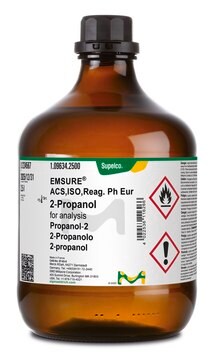W217913
2-Methyl-1-propanol
natural, ≥99%, FCC, FG
Sinónimos:
2-Methyl-1-propanol, Isobutanol, Isobutyl alcohol
About This Item
Fragrance grade
Halal
Kosher
natural
meets purity specifications of JECFA
Productos recomendados
grade
FG
Fragrance grade
Halal
Kosher
natural
agency
follows IFRA guidelines
meets purity specifications of JECFA
reg. compliance
EU Regulation 1223/2009
EU Regulation 1334/2008 & 178/2002
FCC
FDA 21 CFR 117
vapor density
2.55 (vs air)
vapor pressure
8 mmHg ( 20 °C)
8.8 mmHg ( 0 °C)
assay
≥99%
form
liquid
autoignition temp.
801 °F
expl. lim.
10.6 %
greener alternative product characteristics
Less Hazardous Chemical Syntheses
Use of Renewable Feedstocks
Learn more about the Principles of Green Chemistry.
sustainability
Greener Alternative Product
refractive index
n20/D 1.396 (lit.)
bp
108 °C (lit.)
108 °C
mp
−108 °C (lit.)
density
0.803 g/mL at 25 °C (lit.)
application(s)
flavors and fragrances
documentation
see Safety & Documentation for available documents
food allergen
no known allergens
fragrance allergen
no known allergens
greener alternative category
organoleptic
ethereal; wine-like
SMILES string
CC(C)CO
InChI
1S/C4H10O/c1-4(2)3-5/h4-5H,3H2,1-2H3
InChI key
ZXEKIIBDNHEJCQ-UHFFFAOYSA-N
¿Está buscando productos similares? Visita Guía de comparación de productos
Categorías relacionadas
General description
Application
- Volatiles from nutritional fungal symbiont influence the attraction of Anisandrus maiche (Coleoptera: Curculionidae) to ethanol-baited traps.: This investigation revealed that volatiles emitted by fungal symbionts impact the attraction of Anisandrus maiche to ethanol-baited traps. The study suggests potential applications in pest management strategies by utilizing isobutanol and other volatiles (Tobin et al., 2024).
signalword
Danger
hcodes
Hazard Classifications
Eye Dam. 1 - Flam. Liq. 3 - Skin Irrit. 2 - STOT SE 3
target_organs
Central nervous system, Respiratory system
Storage Class
3 - Flammable liquids
wgk_germany
WGK 1
flash_point_f
82.4 °F - closed cup
flash_point_c
28 °C - closed cup
ppe
Eyeshields, Faceshields, Gloves, type ABEK (EN14387) respirator filter
Elija entre una de las versiones más recientes:
¿Ya tiene este producto?
Encuentre la documentación para los productos que ha comprado recientemente en la Biblioteca de documentos.
Los clientes también vieron
Global Trade Item Number
| Número de referencia del producto (SKU) | GTIN |
|---|---|
| W217913-1KG | |
| W217913-4KG | |
| W217913-1KG-K | 4061838248916 |
| W217913-4KG-K | |
| W217913-8KG | |
| W217913-8KG-K | |
| W217913-SAMPLE | |
| W217913-SAMPLE-K | 4061838179647 |
Nuestro equipo de científicos tiene experiencia en todas las áreas de investigación: Ciencias de la vida, Ciencia de los materiales, Síntesis química, Cromatografía, Analítica y muchas otras.
Póngase en contacto con el Servicio técnico










